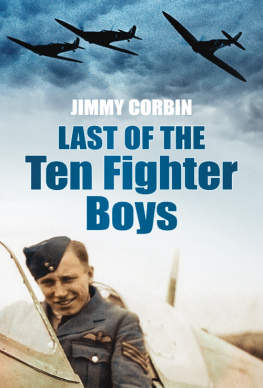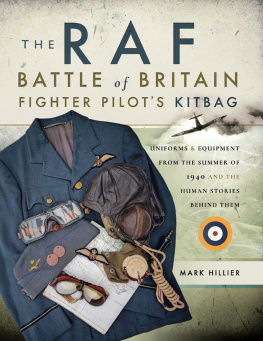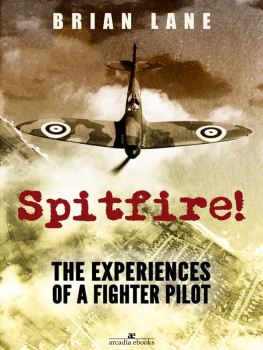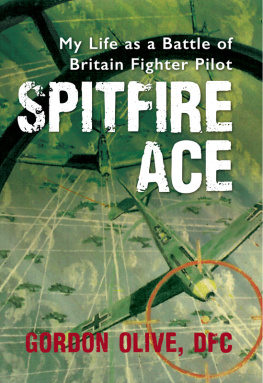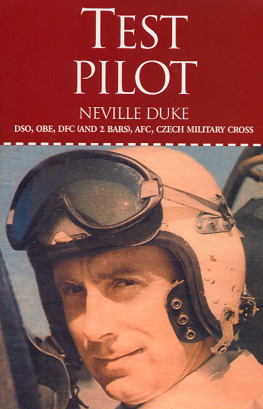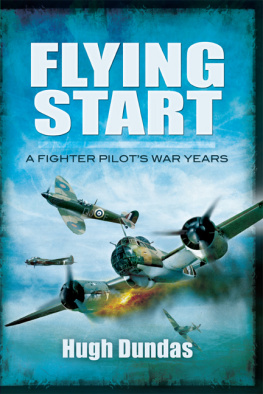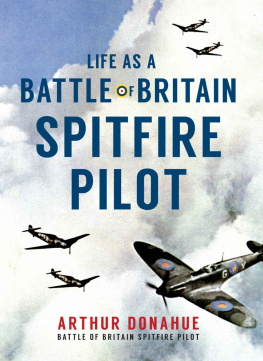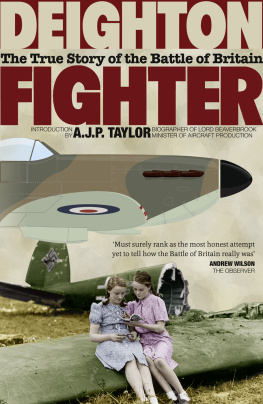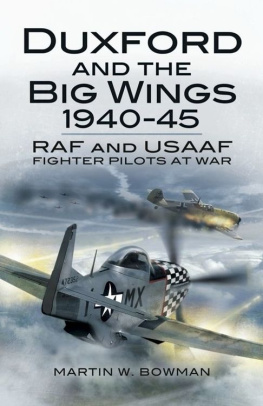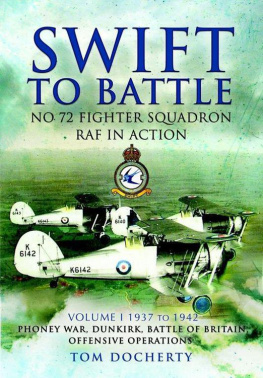LAST OF THE
Ten Fighter Boys
JIMMY CORBIN
To my darling wife Jeanne,
who has put up with me and my selfish ways,
and to my three children,
Brian, Anne and Margot
Cover illustrations. Front, top: Spitfire peeling off to attack in line astern (Bruce Robertson collection); bottom: the author in the cockpit of a Spitfire. Back: the author outside The Dorchester at Burnaston in the winter of 1939-40.
First published in 2007
This edition published in 2010
The History Press
The Mill, Brimscombe Port
Stroud, Gloucestershire, GL 5 2 QG
www.thehistorypress.co.uk
This ebook edition first published in 2011
All rights reserved
Jimmy Corbin, 2007, 2010, 2011
The right of Jimmy Corbin, to be identified as the Author of this work has been asserted in accordance with the Copyrights, Designs and Patents Act 1988.
This ebook is copyright material and must not be copied, reproduced, transferred, distributed, leased, licensed or publicly performed or used in any way except as specifically permitted in writing by the publishers, as allowed under the terms and conditions under which it was purchased or as strictly permitted by applicable copyright law. Any unauthorised distribution or use of this text may be a direct infringement of the authors and publishers rights, and those responsible may be liable in law accordingly.
EPUB ISBN 978 0 7524 6836 5
MOBI ISBN 978 0 7524 6837 2
Original typesetting by The History Press
C ONTENTS
L IST OF I LLUSTRATIONS
1. Flt Lt Jimmy Corbin DFC.
2. Walter Corbin, the authors father.
3. Daisy Lizzie Corbin, the authors mother.
4. The author, aged 4, in a cart made by his father.
5. The author, aged 15, and a friend at the Scout Jamboree, Maidstone.
6. Shoreditch College: the staff and class of 19348.
7. The propeller tip of the Miles Master that was presented to the author at Cranfield.
8. No. 1 War Course, Burnaston, Derby, 193940.
9. The author outside The Dorchester, Burnaston, 193940.
10. Flt Lt Hubert Dizzy Allen DFC, 66 Squadron.
11. Plt Off John Durex Kendal, Rastus, Plt Off Hubert Dizzy Allen and Pookie.
12. No. 66 Squadron, Gravesend, October 1940.
13. Flg Off Peter King, 66 Squadron.
14. Dizzy Allen and John Pickle Pickering, 66 Squadron, 1941.
15. Sqn Ldr Athol Forbes DFC, 66 Squadron.
16. The author in the cockpit of a Spitfire, 66 Squadron, 1941.
17. No. 610 Squadron, Acklington, September 1940.
18. Long-range Spitfire Mk II, Portreath, 1941.
19. Central Gunnery School, Sutton Bridge, April 1942.
20. The authors flying log book entries, 66 Squadron, Biggin Hill, November 1940.
21. No. 72 Squadron at Souk El Chemis, North Africa, 1943.
22. No. 72 Squadron pilots with a visiting VIP.
23. The author, Jupp and Le Cheminant, North Africa, 1943.
24. The authors flying log book, 1943, and silk escape maps.
25. British fighter shot down over North Africa, 1943.
26. Miles Martinet, No. 11 Armament Practice Camp, 1945.
27. Crews at No. 11 Armament Practice Camp, 1945.
28. Flying log book entries, 72 Squadron, Souk El Arba, December 1942.
29. The author at home in Kent, 2006.
30. The author after the war in his demob raincoat.
31. The staff of Maidstone Technical School, 1957.
A CKNOWLEDGEMENTS
A s I sit in front of my log fire reflecting on my life and nursing a glass of whisky (purely for medicinal reasons) I realise how lucky I have been. Lucky to have been born into a loving family who gave me every chance to succeed. Lucky to have survived the war and to have met so many fantastic people during my years of service. Lucky to have lived life to the full and to have made friends who have lasted a lifetime. Very lucky to have met my wife Jeanne who has been so marvellous to me over the years and together we have been lucky to raise three fantastic children. Lucky to now have five wonderful grandchildren. It is to my wife, Jeanne, my children, Brian, Anne and Margot, and my grandchildren, Megan, Thomas, Andrew, Daniel and Emma, to whom this book is dedicated, together with the memory of so many wonderful friends, many of whom are now lost to us, from my period of service during the Second World War.
I am also indebted to Tina, a young and exciting writer who has held my hand, quite literally at times, through the whole process of creating this book and to her a big heartfelt thank you. Through her patience and her tolerant and warm personality she managed to draw out long-forgotten memories.
I raise my glass to my family, whom I love, and to Tina in thanks.
What was the war to me? A period during which I was at times bloody scared and just happy to survive.
P ROLOGUE T EN F IGHTER B OYS
I n September 1939 Britain declared war on Germany. By July the following year the fighting had begun in earnest. For four long months, the German Air Force, the Luftwaffe, sent hundreds of bombers and fighter planes to attack Britains shores to wipe out her air defences in preparation for a full-scale land invasion. Day after day hordes of enemy aircraft crossed the Channel in their quest to obliterate the RAFs airbases and render them useless. But, it wasnt to be. Although heavily outnumbered by the Luftwaffe, the Royal Air Force fought hard to prevent the Germans taking control of the air. By November 1940, the fighter-boys had triumphed and, unable to penetrate Britains air defences, the Germans shelved plans to invade the island. The Battle of Britain was over, but the war was just beginning.
It was against this backdrop that I was first asked to record my experiences as a young Spitfire pilot fighting in the Battle of Britain. But my brief dalliance with writing came about quite by chance.
It was a typically grey winters day and the Spitfire pilots of 66 Squadron, including myself, had safely returned from a sortie and were gathered in the dispersal room at Biggin Hill aerodrome. Conversation ebbed and flowed as it always did and turned rather optimistically towards what we would all do after the war had ended and we went our separate ways.
For me the dye was cast. As a trained teacher I would exchange the battlefields for the classroom, if I survived the war. One of the other pilots, I cant recall who, spoke about his plans to take some Spitfires or kites as we called them to the United States where he would stage mock dogfights for the paying public.
Squadron Leader (Sqn Ldr) Athol Forbes joined the conversation. He had always wanted to be a writer and he had decided that when the war finished he would record about his experiences of leading 66 Squadron during the Battle of Britain, just as many of the flying aces of the Great War had done 20 years previously.
Suddenly our skipper had a brainwave. Instead of waiting until war was over, he suggested that we should all write down then and there what it was like to be a Spitfire pilot living through one of the greatest aerial battles of all time. We all agreed because he was our commanding officer after all, but, in truth, I thought nothing more of it.
The following day Sqn Ldr Forbes put his ideas into action and selected a number of pilots to take part in the project. His choice included a disparate mix of pilot officers and sergeant pilots from all different backgrounds. There were dockhands, clerks, mechanics and teachers, but at that time we all shared the same profession Spitfire pilot.
In between flying sorties against the Germans, the pilots began to scribble down their thoughts on what it was like to face the daily onslaught of the German air force in an aerial war that had possessed enough military significance for Winston Churchill to refer to it as the Battle of Britain. They wrote about what it was like to have a Messerschmitt Me109 locked onto your tail, what it was like to be shot down or to be forced to bale out. They wrote about what it felt like to shoot down your first enemy aircraft and watch it explode in front of you or spiral earthwards to its doom trailing a plume of black smoke.

